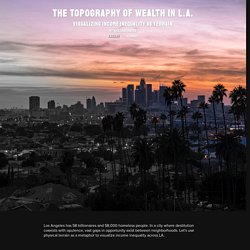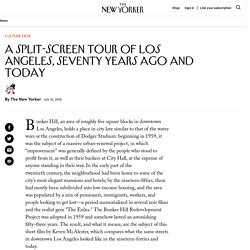

Southland, ou la traversée des frontières à Los Angeles. Dossier : La ville des séries télé Apparue sur les écrans de la chaîne hertzienne américaine NBC au printemps 2009, la série policière Southland fut immédiatement louée pour sa représentation quasi-documentaire de Los Angeles.

Toutefois, son traitement rude et sans concession, accentué par des tournages principalement en extérieur et en lumière « brute », ne séduisit pas un large public, et la série fut reprise à la fin des sept épisodes de sa première saison par la chaîne câblée TNT, qui diffusa les deux saisons suivantes. Elle s’apprête aujourd’hui à en diffuser une quatrième, avec toutefois un budget sensiblement réduit. C’est essentiellement grâce à des partis pris de réalisation assez inhabituels pour une série télévisée que Southland permet de mieux cerner les particularités géographiques de Los Angeles. Los Angeles : du décor au personnage.
Los Angeles International – potentially a model for the operation of large hub airports. Los Angeles’ economy – more than just entertainment Los Angeles is the cultural, financial, and commercial centre of Southern California, with an estimated (2016) population of 3,976,322, making it the second most populous U.S. city after New York.

But the urban area sprawls well beyond its boundaries, despite it being surrounded on three sides by mountains and by the Pacific Ocean on the fourth. The metropolitan area embraces over 13 million people, while the five-county Southern California (So-Cal) region runs to 18.7 million – again, itself the second most populous after the New York metropolitan area.
It is the largest manufacturing centre in the western U.S., and the contiguous ports of Los Angeles and Long Beach (just to the south of LAX) are the fifth busiest in the world, with a particular emphasis on the Pacific Rim. While it is a financial centre, it is perhaps not as important as are other cities. The area is served by three main airports. A good seat balance between regions and. Visualizing Income Inequality. Los Angeles has 58 billionaires and 58,000 homeless people.

In a city where destitution coexists with opulence, vast gaps in opportunity exist between neighborhoods. Let's use physical terrain as a metaphor to visualize income inequality across LA. Extreme income inequality raises troubling questions about the health of our society and our capacity for empathy. Politicians are quick to trumpet figures such as gross GDP and unemployment rates as evidence for a thriving economy. Rarely do they paint the true picture, of a nation at once bloated and starving, marked by historic, persistent, and racialized economic inequality. “...when you have seen hate-filled policemen curse, kick, brutalize, and even kill your black brothers and sisters with impunity; when you see the vast majority of your twenty million Negro brothers smothering in an airtight cage of poverty in the midst of an affluent society...then you will understand why we find it difficult to wait. A Los Angeles, un quartier se rebiffe contre la "gentrification"
Tout a commencé un matin lorsqu'Eva Chimento a trouvé mystérieusement ouverte la porte de sa galerie de Boyle Heights, un quartier hispanique de Los Angeles.

Une autre fois, la serrure a été forcée. "Et j'ai reçu une lettre d'une artiste qui m'invitait à une réunion d'un groupe de femmes, +The Ovarian Psychos+ (les psychopathes ovariennes) pour parler de la gentrification", le processus d'embourgeoisement des quartiers populaires, explique à l'AFP la galeriste brune au large sourire. A Split-Screen Tour of Los Angeles, Seventy Years Ago and Today. Bunker Hill, an area of roughly five square blocks in downtown Los Angeles, holds a place in city lore similar to that of the water wars or the construction of Dodger Stadium: beginning in 1959, it was the subject of a massive urban-renewal project, in which “improvement” was generally defined by the people who stood to profit from it, as well as their backers at City Hall, at the expense of anyone standing in their way.

In the early part of the twentieth century, the neighborhood had been home to some of the city’s most elegant mansions and hotels; by the nineteen-fifties, these had mostly been subdivided into low-income housing, and the area was populated by a mix of pensioners, immigrants, workers, and people looking to get lost—a period memorialized in several noir films and the realist gem "The Exiles. " The Bunker Hill Redevelopment Project was adopted in 1959 and somehow lasted an astonishing fifty-three years.